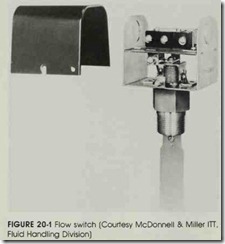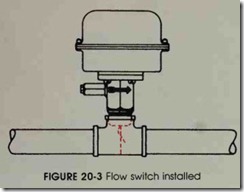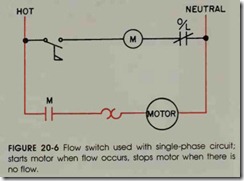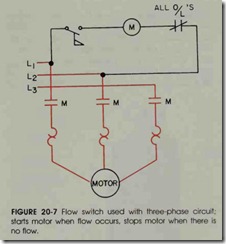Objectives
After studying this unit, the student will be able to:
• Describe the purpose and functions of flow switches
• Connect a flow switch to other electrical devices
• Draw and r ad wiring diagrams of systems using flow switches
A flow switch is a device that can be inserted in a pipe so that when liquid or air flows against a part of the device called a paddle, a switch is ac tivated (figure 20-1). This switch either closes or opens a set of electrical contacts. The. contacts may be connected to energize motor starter coils, relays, or indicating lights. In general, a flow switch contains both normally open and normally closed electrical contacts, figure 20-2.
Figure 20-3 shows a flow switch installed in a pipe line tee. Half couplings are welded into larger pipes for flow switch installations.
Typical applications of flow switches are shown in figures 20-4 through 20-7. These appli cations are commonly found in the chemical and petroleum industries. Vaporproof electrical con nections must be used with vaporproof switches. The insulation of the wire leading to the switches must be adequate to withstand the high temperature of the liquid inside the pipe. (Consult the Na tional Electric Code for insulation temperature rat ings.)
Airflow or sail switches are also used in ducts in air conditioning systems. Another use of these switches is to prevent duct heaters from energizing when there is no air movement in the duct. While the construction of airflow switches is different from that of liquid flow switches, the electrical connections are similar.
The schematic symbols for a flow switch are
shown in figure 20-8 .
REVIEW QUESTIONS
1. What are typical uses of flow switches?
2. Draw a line diagram to show that a green light will glow when liquid flow occurs.
3. Draw a one-line diagram showing a bell that will ring in the absence of flow.
Include a switch to turn off the bell manually.







